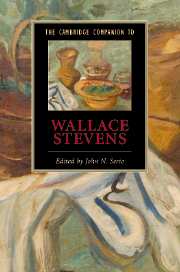Book contents
- Frontmatter
- Introduction
- 1 Wallace Stevens: A Likeness
- 2 Stevens and Harmonium
- 3 Stevens in the 1930s
- 4 Stevens and the supreme fiction
- 5 Stevens’ late poetry
- 6 Stevens and his contemporaries
- 7 Stevens and romanticism
- 8 Stevens and philosophy
- 9 Stevens’ seasonal cycles
- 10 Stevens and the lyric speaker
- 11 Stevens and linguistic structure
- 12 Stevens and painting
- 13 Stevens and the feminine
- 14 Stevens and belief
- Further reading
- Index
5 - Stevens’ late poetry
Published online by Cambridge University Press: 28 May 2007
- Frontmatter
- Introduction
- 1 Wallace Stevens: A Likeness
- 2 Stevens and Harmonium
- 3 Stevens in the 1930s
- 4 Stevens and the supreme fiction
- 5 Stevens’ late poetry
- 6 Stevens and his contemporaries
- 7 Stevens and romanticism
- 8 Stevens and philosophy
- 9 Stevens’ seasonal cycles
- 10 Stevens and the lyric speaker
- 11 Stevens and linguistic structure
- 12 Stevens and painting
- 13 Stevens and the feminine
- 14 Stevens and belief
- Further reading
- Index
Summary
When his last volume of new poems, The Auroras of Autumn, was published in 1950, Wallace Stevens was a month from his seventy-first birthday, and the publication of his Collected Poems was timed to coincide with his seventy-fifth. The final section of the Collected Poems, The Rock, comprised twenty-five previously uncollected poems, written when Stevens was in his seventies. These two collections affirm that age had diminished neither Stevens' energy nor his artistry - the title poem of The Auroras of Autumn is the work most often nominated as his greatest long poem, and many readers would agree with Harold Bloom that “Stevens' last phase (1950-55) was his best.” The poems written during this five-year period (the poems of The Auroras of Autumn were written between 1947 and 1949) also inaugurate a fresh pared-down style that makes them the most accessible of Stevens' poems.
Although difficult from the beginning, Stevens' poetry had become increasingly theoretical and abstract, and thus increasingly obscure, since Parts of a World in 1942, and The Auroras of Autumn represents the culmination of this tendency. Coming directly after this demanding poetry, the poems of The Rock are unexpectedly plain, stripped of the imaginative flourishes and epistemological quandaries of the preceding volumes. Stevens' late poems are thus not of a piece formally or stylistically, even if they address many of the same themes.
- Type
- Chapter
- Information
- The Cambridge Companion to Wallace Stevens , pp. 62 - 75Publisher: Cambridge University PressPrint publication year: 2007
- 5
- Cited by

